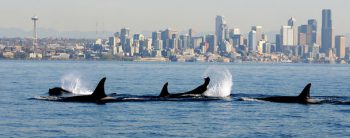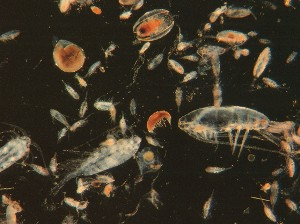Orcas in Puget Sound – What Are They Really Eating?
By Amy Brodbeck

What do pink pigeons, wild yaks, and orcas in Puget Sound have in common? They’re all endangered in the federal Endangered Species Act (ESA). Here in Washington, the orcas of concern are part of the Southern Resident orca population. This population spends most of their days in the Salish Sea, but disperse in the winter and have recently been sighted as far south as Monterey Bay, California and as far north as Chatham Strait in southeast Alaska.
The National Oceanic and Atmospheric Administration (NOAA) has developed a complex recovery plan aimed to bring these orcas back to the point where they no longer require the protections of the Endangered Species Act. This goal, however, is no small feat. But the big question remains unanswered—Why are the Southern Resident orcas endangered?

Today, the Southern Resident orcas face three main threats: vessel disturbance, scarcity of food, and marine pollution. Let’s zoom into this last issue, as Puget Sound pollution has recently been in the limelight; researchers have found that some Puget Sound salmon were essentially ‘on drugs’ as a result of human drugs entering the Sound through human wastewater. In addition to this flow, Puget Sound estuaries are contaminated with “legacy” contaminants like PCBs (polychlorinated biphenyls).
To what extent does marine pollution affect an orca’s ability to survive and reproduce? Believe it or not, we still don’t know. Scientists, however, have dug up some relevant clues as to the effects of some of these chemicals.

When these pollutants enter a marine ecosystem via runoff (excess stormwater, etc.), air pollution, or other means, they accumulate in zooplankton or benthic invertebrates, tiny animals at the bottom of the food chain. The toxins are then transferred to the fish that eat them. The toxins are magnified as they accumulate in higher numbers in larger predators that eat more of these contaminated fish, a phenomenon called biomagnification. Marine mammals are easy targets for high levels of contamination because they are often top predators and are also enveloped in a thick layer of fat, called blubber, where many of these toxins are stored. Since the 1960s, scientists have found PCBs in the fat of marine mammals in Puget Sound. PCBs were used in industrial applications, ranging from coolants to wood floor finishes, and though production has been banned in the US since the 1970s, this compound persists in our environment.
For humans, the health risks associated with PCBs are clear. The Washington State Department of Health confirms that childhood exposure to toxins such as PCBs may lead to immune deficiencies, and learning and behavioral problems. It recently published a fish consumption advisory that urges consumers to eat resident Puget Sound salmon less frequently than twice a month, due to their high levels of contamination. Fortunately, humans have the luxury of avoiding contaminated seafood, but this is not true for Southern Resident orcas. In a recent report, “10 Years of Research & Conservation,” NOAA reveals that Chinook salmon make up the majority of the Southern Resident orca diet.
Though scientists cannot yet pinpoint the exact toxin concentrations required to negatively affect the survival and reproductive capacity of these orcas, they have solid evidence that reveals their vulnerability. In 1984, a stranded orca in Puget Sound had dangerously high levels of PCBs stored in its fat; from 1988-1997, five stranded orcas found in Oregon also carried large concentrations of PCBs. Other studies reveal how these persistent pollutants cause immune or reproductive system dysfunction in these animals.
In more recent news, marine pollution could also be the cause of a male-dominated baby boom in our Southern Resident orcas. Nine male calves versus one female calf recently entered this world. Exciting? Yes! Cause for concern? Maybe. Researchers worry that this skewed sex ratio could be caused by marine pollution that has the potential to alter hormone function (endocrine disrupting chemicals).
Whether you have seen them from a ferry or whale watching boat in the San Juan Islands, orcas spark the imagination. These powerful top predators need our help.
As proud human Puget Sound residents, we can help keep contaminants out of stormwater in three major ways. First, we can use a commercial carwash or wash our cars over lawns, not driveways or streets. Both vegetation and commercial car washes filter water before it returns to ground water or Puget Sound. Secondly, we can keep cars and trucks well maintained to avoid any oil leaks, and be sure to recycle oil, antifreeze, batteries and other toxic chemicals through the appropriate channels. Finally, we can think about the fertilizers, pesticides, and herbicides we use—what chemicals are in them? Using organic fertilizers, or better yet, planting drought-resistant plants that may not need as much ‘boosting’ to grow in the balmy summer heat are great options. To prevent our human drugs from getting into the marine environment, we can seek out the medicine drop-off facilities around the state to properly dispose of unwanted or expired medications.
What else do you do to keep Puget Sound clean?
References for further reading
NOAA. (2014). Southern Resident Killer Whales: 10 Years of Research & Conservation Report Executive Summary. Retrieved from http://www.nwfsc.noaa.gov/news/features/killer_whale_report/pdfs/summary.pdf
Hayteas, D. L., & Duffield, D. A. (2000). High levels of PCB and p, p′-DDE found in the blubber of killer whales (Orcinus orca). Marine Pollution Bulletin,40(6), 559-561.
NOAA. (n.d.) Endangered Species Act Status of Puget Sound Killer Whales. Retrieved from http://www.westcoast.fisheries.noaa.gov/protected_species/marine_mammals/killer_whale/esa_status.html